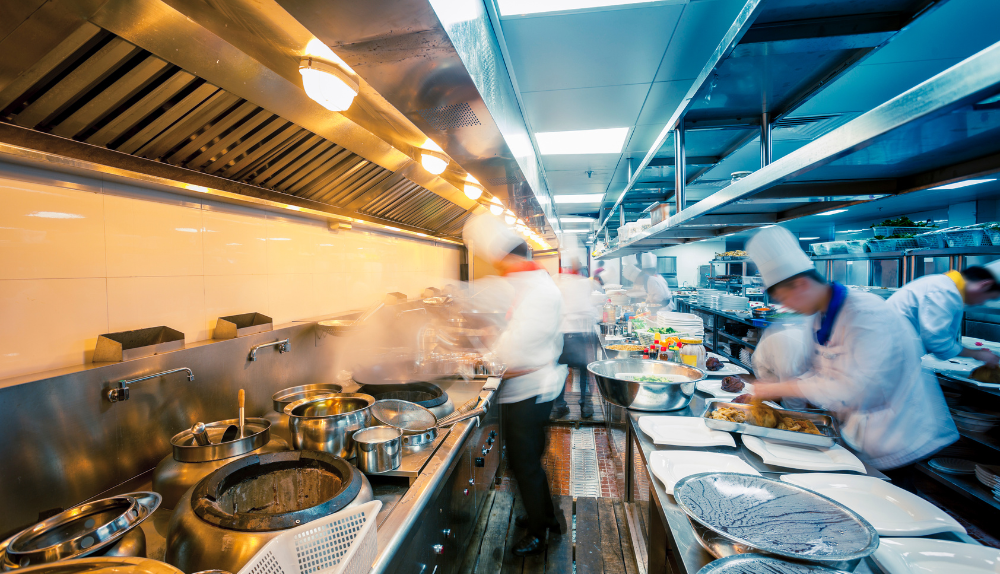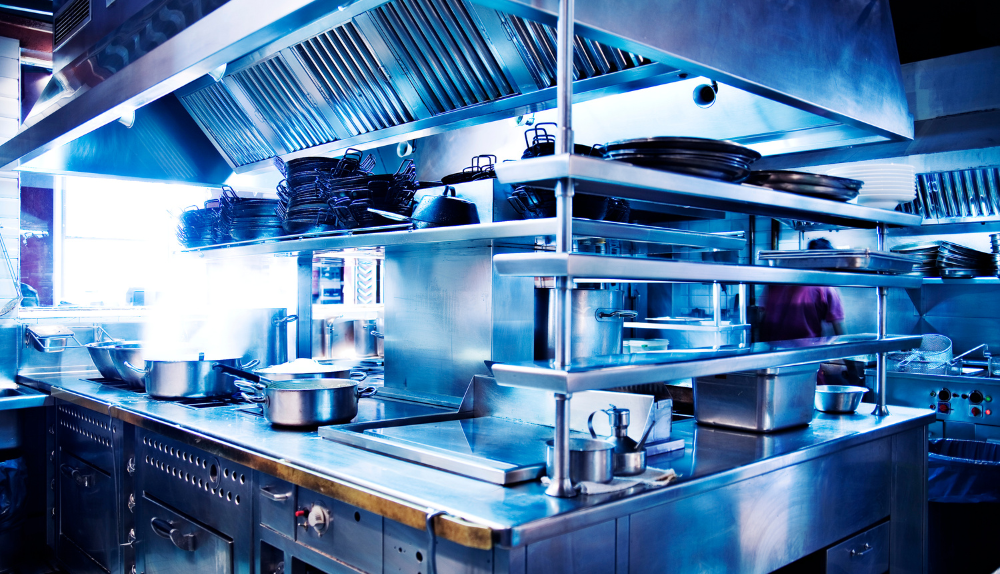Get ready to indulge your senses and dive headfirst into a mouthwatering journey through the fascinating world of culinary commerce! Today, we're pulling back the curtain on a hidden culinary gem that deserves your undivided attention – the kitchen appreciation fee. Ever heard of it? Get ready to have your taste buds tingling and your curiosity piqued as we uncover the mysteries behind this intriguing fee that quietly makes its way onto your restaurant bill. From its purpose and controversies to its impact on both diners and the restaurant industry, we're about to embark on a delectable exploration that will leave you hungry for more. So, loosen your belts and prepare to savor the enticing flavors of the kitchen appreciation fees – it's time to dig in!
 In recent years, an increasing number of restaurants have started implementing a kitchen appreciation fee as a response to wage disparities and acknowledging the crucial role played by the kitchen staff. Let's delve into the reasons behind this emerging trend.
In recent years, an increasing number of restaurants have started implementing a kitchen appreciation fee as a response to wage disparities and acknowledging the crucial role played by the kitchen staff. Let's delve into the reasons behind this emerging trend.
What is Kitchen Appreciation Fee?
The kitchen appreciation fee is a relatively new concept in the restaurant industry that has gained attention and sparked debates among diners and restaurateurs alike. Essentially, it is an additional charge added to a diner's bill to recognize and compensate for the hard work and talent of the kitchen staff behind the scenes. This fee addresses the wage disparities between front-of-house staff, such as servers who receive tips, and back-of-house staff, including chefs, line cooks, and dishwashers, who often earn lower wages. The purpose of the kitchen appreciation fees is twofold. First, it aims to bridge the wage gap by redistributing some of the revenue generated from diners to the kitchen staff, who contribute significantly to the dining experience. Second, it intends to raise awareness among patrons about the often-unsung heroes in the kitchen and the demanding labor they undertake. However, the implementation and acceptance of the kitchen appreciation fees have been met with mixed reactions. Some diners appreciate the transparency and understanding of the fee's purpose, gladly paying it to support fair wages. Others, however, feel that it is the responsibility of the restaurant owners to ensure equitable pay without passing on the cost to the customers. Ultimately, the kitchen appreciation fee has become a point of discussion and reflection on the complex dynamics of the restaurant industry, highlighting the value and recognition of the often-overlooked kitchen staff.Why Are Restaurants Introducing Kitchen Appreciation Fees?
 In recent years, an increasing number of restaurants have started implementing a kitchen appreciation fee as a response to wage disparities and acknowledging the crucial role played by the kitchen staff. Let's delve into the reasons behind this emerging trend.
In recent years, an increasing number of restaurants have started implementing a kitchen appreciation fee as a response to wage disparities and acknowledging the crucial role played by the kitchen staff. Let's delve into the reasons behind this emerging trend.
Bridging the Wage Gap
One of the primary motivations for introducing the kitchen appreciation fees is to address the wage disparity between front-of-house and back-of-house staff. Traditionally, servers and waitstaff have relied on tips as a significant portion of their income, often earning higher wages compared to kitchen staff. By adding a specific fee, restaurants can redistribute a portion of the revenue to the kitchen team, ensuring a fairer compensation structure.Recognizing Underrated Efforts
The kitchen staff, including chefs, line cooks, and dishwashers, often work tirelessly behind the scenes to deliver exceptional dining experiences. However, their efforts often go unnoticed or underappreciated by diners. The kitchen appreciation fee serves as a means to recognize and highlight their essential contributions to the overall success of a restaurant.Transparency and Fairness
By implementing a separate fee, restaurants aim to be transparent with customers about where their money goes and how it is allocated. This fee provides a clearer understanding of how the revenue is shared between the front-of-house and back-of-house teams. It ensures that the entire staff, who collectively create the dining experience, receive their fair share.Supporting Sustainable Practices
The introduction of a kitchen appreciation fee can also contribute to the sustainability and longevity of the restaurant industry. Fair compensation for kitchen staff can help retain talented individuals, reducing turnover rates and maintaining a skilled workforce. Moreover, it encourages a more inclusive and equitable work environment, fostering employee satisfaction and loyalty.Raising Customer Awareness
The kitchen appreciation fees serves as an educational tool, informing diners about the complexities of the restaurant industry. It sheds light on the challenges faced by kitchen staff and the importance of fair wages. By creating awareness, restaurants hope to cultivate empathy and support from their customers. While the introduction of the kitchen appreciation fee has generated mixed reactions, it represents a step towards a more equitable and sustainable restaurant industry. As customers become more conscious of the behind-the-scenes efforts, this fee serves as a means to bridge the wage gap, recognize the hard work of kitchen staff, and create a fairer dining experience for all parties involved.Best Practices Around Kitchen Fees and What to Avoid
The implementation of a kitchen appreciation fee has become a topic of discussion and experimentation within the restaurant industry. While it aims to address wage disparities and acknowledge the contributions of kitchen staff, restaurants need to approach such fees with care and consideration. In this article, we will explore the best practices surrounding kitchen fees and highlight what restaurants should avoid to ensure a positive and fair dining experience for both customers and staff.Best Practices
Transparent Communication
Restaurants should clearly communicate the purpose and breakdown of the kitchen appreciation fees to their customers. This can be done through menu inserts, signage, or staff education. Transparency builds trust and allows customers to understand where their money is going.Education and Awareness
Alongside implementing the fee, it is crucial for restaurants to educate their customers about the reasons behind it. This can be done through website explanations, social media posts, or even in-person interactions. Raising awareness about wage disparities and the value of kitchen staff helps customers appreciate the fee's purpose and supports a more inclusive dining culture.Fair Distribution
Restaurants should ensure that the kitchen fee is distributed equitably among the back-of-house staff. It is vital to have a clear system in place for how these funds are allocated. This can involve considering factors such as position, experience, and hours worked. Transparent distribution practices contribute to a harmonious work environment and promote staff satisfaction.Wage Structure Evaluation
Introducing a kitchen appreciation fees should prompt restaurants to evaluate their overall wage structure. It is essential to ensure that all employees receive fair compensation, not just the kitchen staff. Restaurants should assess their tipping policies, base wages, and benefits to create a more balanced and sustainable system.Collaboration with Staff
Involving the kitchen staff in the decision-making process regarding the fee implementation is crucial. Seek their input and address their concerns. By fostering a collaborative environment, restaurants can ensure that the fee is well-received and supported by the very individuals it intends to benefit.Continual Evaluation
Restaurants should periodically assess the impact and effectiveness of the kitchen appreciation fee. Monitor feedback from both customers and staff to gauge its success. This ongoing evaluation enables adjustments and improvements to be made to the fee structure over time, ensuring it remains aligned with the restaurant's values and objectives.What to Avoid
Lack of Transparency
Failing to clearly communicate the purpose and breakdown of the kitchen appreciation fee can lead to confusion and resentment among customers. Avoiding ambiguity is crucial to maintain trust and preventing negative perceptions.Unfair Distribution
Improper distribution of the kitchen fee can cause disharmony and dissatisfaction among the back-of-house staff. Ensure that funds are allocated fairly and consistently, based on agreed-upon criteria.Passing Costs onto Customers
Restaurants should avoid using the kitchen appreciation fee as a means to shift the responsibility of fair wages entirely onto the customers. It is the restaurant's duty to create a sustainable business model that supports equitable compensation for all employees.Inadequate Education
Neglecting to educate customers about the reasons behind the fee can lead to skepticism and resistance. Restaurants should take proactive measures to explain the fee and the larger context of wage disparities within the industry.Lack of Employee Engagement
Excluding the kitchen staff from the decision-making process regarding the fee can result in resentment and misunderstandings. Involve employees in the conversation, seek their input, and address their concerns to ensure a more cohesive and supportive work environment.Inflexibility
Restaurants should be open to feedback and willing to make adjustments to the fee structure as needed. Rigid policies can hinder the effectiveness of the fee and prevent it from truly benefiting both staff and customers. By adhering to best practices and avoiding common pitfalls, restaurants can successfully implement a kitchen appreciation fees that promotes fairness, transparency, and appreciation within the dining experience. When implemented thoughtfully and with the well-being of both customers and staff in mind, kitchen fees have the potential to contribute positively to the industry's overall sustainability and equity.Alternatives to Kitchen Appreciation Fees
While kitchen appreciation fees have gained traction as a means to address wage disparities and recognize the contributions of kitchen staff, some restaurants may prefer alternative approaches that align with their values and operational structure. Here are several alternatives to consider:Revenue Sharing Model
Rather than adding a separate fee to customers' bills, restaurants can implement a revenue-sharing model. In this approach, a portion of the overall revenue is allocated to the kitchen staff as a direct percentage of sales. This ensures that all employees, including kitchen staff, benefit from the success of the restaurant without burdening customers with an additional fee.Menu Price Adjustment
Restaurants can adjust their menu prices slightly to account for fair wages for both front-of-house and back-of-house staff. By factoring in higher wages during menu pricing, restaurants can distribute the cost across all menu items. This approach creates a more equitable compensation structure without requiring customers to pay a separate fee.Inclusive Service Charge
Instead of a kitchen fee, restaurants can introduce an inclusive service charge. This charge would be a percentage added to the total bill, covering both service and kitchen staff wages. The benefit of this approach is that it transparently communicates the distribution of funds to customers and ensures a fairer compensation structure for all employees.Mandatory Gratuity
Restaurants can opt for a mandatory gratuity policy where a specific percentage of the bill is automatically added as a service charge. This approach ensures a consistent level of compensation for both front-of-house and back-of-house staff, eliminating the need for a separate kitchen fee. However, it is crucial for restaurants to communicate this policy to customers to avoid misunderstandings clearly.Menu Highlighting and Staff Appreciation
Restaurants can highlight the culinary team's efforts, their expertise, and the use of quality ingredients. An alternative approach is to emphasize the importance of kitchen staff through menu descriptions and dedicated staff appreciation initiatives. Additionally, recognizing and appreciating kitchen staff during staff meetings, on social media platforms, or through internal reward systems can help create a positive work environment.Staff Incentive Programs
By fostering a culture of recognition and growth, restaurants can motivate and retain talented kitchen staff. Restaurants can implement staff incentive programs that reward kitchen staff based on performance, customer feedback, or other criteria. These programs can include bonuses, profit-sharing plans, or career development opportunities.Collaborative Revenue Allocation
Some restaurants choose to involve their staff in revenue allocation decisions. By creating a collaborative approach, where staff members collectively decide on how revenue is distributed among the team, restaurants can foster a sense of ownership and fairness. This approach ensures that all staff members, including kitchen staff, have a voice in determining compensation structures.Wage Structure Evaluation and Adjustment
By addressing wage disparities holistically, restaurants can create a more equitable environment for their entire staff. Restaurants can evaluate their wage structures and make adjustments to ensure fair compensation for all employees. This may involve increasing base wages, revising tipping policies, or providing comprehensive benefits packages. When considering alternatives to kitchen appreciation fees, it is crucial for restaurants to align their chosen approach with their values, operational capabilities, and customer expectations. By focusing on fair compensation, transparency, and appreciation for all staff members, restaurants can create a positive work environment and deliver an exceptional dining experience to their customers.Pros and Cons of Kitchen Appreciation Fees
Kitchen fees, also known as kitchen appreciation fees or Back-of-House Fees, have sparked debates and discussions within the restaurant industry. While these fees aim to address wage disparities and recognize the efforts of kitchen staff, they come with their own set of advantages and disadvantages. Let's explore the pros and cons of kitchen fees:Pros
- Fair Compensation: Kitchen fees provide an opportunity to bridge the wage gap between front-of-house and back-of-house staff. By redistributing a portion of the revenue to the kitchen staff, these fees can help ensure fair compensation for their essential contributions to the dining experience.
- Transparent Revenue Allocation: Adding a separate fee allows for transparent communication with customers about where their money goes. This transparency builds trust and enables customers to understand how their financial support benefits the entire restaurant team.
- Awareness and Appreciation: Kitchen fees raise awareness among customers about the often-underappreciated work of kitchen staff. By acknowledging their efforts, these fees can foster a greater appreciation for the skill, labor, and creativity that goes into preparing meals.
- Sustainability and Retention: The implementation of kitchen fees can contribute to a more sustainable business model by allowing restaurants to allocate funds for fair wages. This, in turn, can help attract and retain talented kitchen staff, reducing turnover rates and maintaining a skilled workforce.
Cons
- Customer Resistance: Some customers may resist or feel reluctant to pay an additional fee on top of their bill. The introduction of kitchen fees may lead to negative reactions, especially if customers are not adequately informed about the purpose and breakdown of the fee.
- Complexity and Confusion: The implementation of kitchen fees can add complexity to the dining experience. Customers may find it challenging to understand the rationale behind the fee or how it is distributed among the staff. Lack of clarity can lead to confusion and potentially impact customer satisfaction.
- Staff Disparity: While kitchen fees aim to address wage disparities, they may inadvertently create new disparities within the back-of-house staff. Unequal distribution or inadequate fee allocation among kitchen staff can lead to disharmony and employee dissatisfaction.
- Potential Cost Shifting: There is a risk that kitchen fees could be used as a means for restaurants to shift the responsibility of fair wages entirely onto the customers. If the fee is not accompanied by fair base wages for all employees, it may create an additional burden for customers while absolving the restaurant from their responsibility.
- Perception of Hidden Charges: Some customers may perceive kitchen fees as hidden charges that increase the overall cost of dining out. This perception could lead to negative perceptions of the restaurant and impact customer loyalty.





